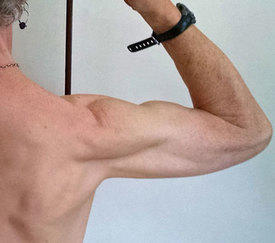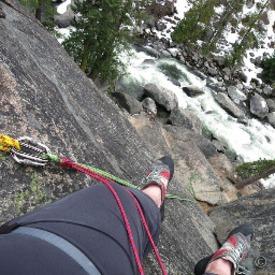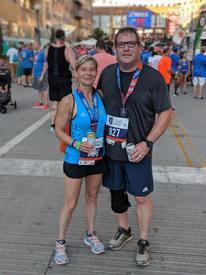Do You Use %MHR Or %HRR For Your Heart Rate Training?

OldAssDude
Posts: 1,436 Member
I have been using %MHR for going on 3 years now, and it got to the point that when I'm in zone 3, it hardly feels like I am even exercising.
Yesterday I set my Garmin fenix 5x to use %HRR, and did a 6 mile trail power walk/run, and now zone 3 feels more in line with what zone 3 should feel like.
For those who do not know what i am talking about, %MHR is calculated using percentage of max heart rate, and %HRR is calculated using percentage of heart rate reserve which is max heart rate minus resting heart rate.
I am 60 years old with a resting heart rate of 65, and a max heart rate of 160 (verified by a stress test).
Below is an example of what my zones look like...
Using % MHR
Zone 1 = 80-96 BPM
Zone 2 = 98-112 BPM
Zone 3 = 114-128 BPM
Zone 4 = 130-144 BPM
Zone 5 = 146-160 BPM
Using % HRR
Zone 1 = 113-122 BPM
Zone 2 = 123-132 BPM
Zone 3 = 132-141 BPM
Zone 4 = 142-151 BPM
Zone 5 = 151-160 BPM
You can see using %HRR is more challenging, but as your fitness level improves and you start feeling like you are not getting a good workout, you can use this method to up your game.
Just thought I would share this.
Yesterday I set my Garmin fenix 5x to use %HRR, and did a 6 mile trail power walk/run, and now zone 3 feels more in line with what zone 3 should feel like.
For those who do not know what i am talking about, %MHR is calculated using percentage of max heart rate, and %HRR is calculated using percentage of heart rate reserve which is max heart rate minus resting heart rate.
I am 60 years old with a resting heart rate of 65, and a max heart rate of 160 (verified by a stress test).
Below is an example of what my zones look like...
Using % MHR
Zone 1 = 80-96 BPM
Zone 2 = 98-112 BPM
Zone 3 = 114-128 BPM
Zone 4 = 130-144 BPM
Zone 5 = 146-160 BPM
Using % HRR
Zone 1 = 113-122 BPM
Zone 2 = 123-132 BPM
Zone 3 = 132-141 BPM
Zone 4 = 142-151 BPM
Zone 5 = 151-160 BPM
You can see using %HRR is more challenging, but as your fitness level improves and you start feeling like you are not getting a good workout, you can use this method to up your game.
Just thought I would share this.
0
Replies
-
HHR reserve is the only reliable way to calculate HR training zones. Taking just a % MHR has a significant (like 15%-25%) error factor.1
-
-
Neither. I use lactate threshold. Or I should say I 'used' LT. This year I am going by pace and feel. I still wear my HRM most of the time, but pay little attention to it.2
-
Neither. I use lactate threshold. Or I should say I 'used' LT. This year I am going by pace and feel. I still wear my HRM most of the time, but pay little attention to it.
I go by both feel and HR. That is how I noticed that I felt like I was barely exercising, yet I was in zone 3.
Almost 3 years ago I was obese and extremely out of shape, and I felt like I was dying in zone 2...LOL
My RHR back then was in the high 80's, and now it's 65 on average.1 -
I use what my coach tells me. He has all my max/resting/threshold numbers. He gives me what HR numbers to be in for whatever period of time/activity and that’s what I do. But I don’t do a whole lot in that middle range regardless of how it’s calculated (except for long races). Lots at the lower end and specific trainings that go into the very high end for short periods of time.1
-
bcalvanese wrote: »
Most people don't have a tested max, many don't know an accurate resting, and %MHR is just one more simplification that lets blog writers and such give people numeric recommendations based only on age (if they even bother with that). IMO, RPE should work fine for most sub-elites - self-honest ones, anyway - but it's not as tecnical-sounding and sexy.
- but it's not as tecnical-sounding and sexy.
When I was training in a structured way, I used %HRR, because I do have a tested MHR (rowing ergometer step test) and RHR, but no tested LT. Now that I seem to have gotten racing out of my system (or simply gotten old and lazy ), I still pay some attention to HRR ranges, to check that I mix things up a bit and regularly get some intensity during active fun. (BTW: almost 62 y/o, MHR 180, AM RHR high 40s to low 50s depending on season).
), I still pay some attention to HRR ranges, to check that I mix things up a bit and regularly get some intensity during active fun. (BTW: almost 62 y/o, MHR 180, AM RHR high 40s to low 50s depending on season).
I think what your goals are matters, along with which data points you have as input. For simple weight loss, most of these appealing technical details are all frosting and no cake; for fitness and sub-elite competition honest RPE should work, but %HRR is less subjective if you have tested (or even sub-max test estimated) inputs; LT is great but harder to get tested/track for I'm not sure how much extra benefit. For elites . . . well, they have testing labs and dedicated coaches. JM(amateur)O. 1
JM(amateur)O. 1 -
LTHR.2
-
zones based on LTHR1
-
When I did zone training I based it on actual tested max HR - done as part of a VO2 max test.
I'm dubious just a "stress test" is that accurate as some protocols don't seem to involve any real stress!
Just for comparison with two people close to you in age....
I'm 57 and do loads of cycling my min HR is 48 and tested max 176.
My 62 year old brother who rarely does any cardio apart from walking is about 42 min and 190 max.
Mostly when I'm training indoors I'm working from power rather than HR.
I go by FTP, either estimated from a 20 minute test or an actual one hour test.
Outdoors I use HR and RPE - I've got a pretty good grasp of what HR ranges I can sustain for different durations.
Concept2 MHR test wasn't too far away for me but I hit higher numbers on the cycling step test - probably as I'm a cyclist not a rower.
2 -
I share some generalized skepticism about cardiac stress tests as a max test, too, from my own stress test experience: They made me stop somewhere near age-estimated max, because they had their heart function data, and I think didn't like how I was looking on the treadmill . . . but I'm a rower (with a torn meniscus
 ), not a runner. I gather max is somewhat activity-specific, but I suspect not by that much - IIRC, the stress test people estimated like 20-30 bpm below the rowing step test my coach ran (she was apparently more willing to kill me than they were
), not a runner. I gather max is somewhat activity-specific, but I suspect not by that much - IIRC, the stress test people estimated like 20-30 bpm below the rowing step test my coach ran (she was apparently more willing to kill me than they were  ).
).
However, since OP is an active guy, his perceptions about how close he was to pegged out on the stress test are certainly a better guide to how accurately it estimated his max, than my preconceptions are. 1
1 -
I share some generalized skepticism about cardiac stress tests as a max test, too, from my own stress test experience: They made me stop somewhere near age-estimated max, because they had their heart function data, and I think didn't like how I was looking on the treadmill . . . but I'm a rower (with a torn meniscus
 ), not a runner. I gather max is somewhat activity-specific, but I suspect not by that much - IIRC, the stress test people estimated like 20-30 bpm below the rowing step test my coach ran (she was apparently more willing to kill me than they were
), not a runner. I gather max is somewhat activity-specific, but I suspect not by that much - IIRC, the stress test people estimated like 20-30 bpm below the rowing step test my coach ran (she was apparently more willing to kill me than they were  ).
).
However, since OP is an active guy, his perceptions about how close he was to pegged out on the stress test are certainly a better guide to how accurately it estimated his max, than my preconceptions are.
I am 60 so my MHR should be 160 according to the 220 - age formula, and my stress test showed within a few BPM of that. The way I felt on the treadmill at that point in the test was that I could probably only maintain that level for about a minute or so, so I think it is pretty close to the 220 - age formula (within a few beats).
Just to verify that I have run with a chest strap heart rate monitor about half a dozen times on hilly trails. I would run for a while at a little over 90% of my MHR, and when I hit steep hill I would give it everything I had until I could not go any more. Out of about half a dozen times of doing that, my heart rate was always within a few beats per minute of 160, so in my case I think the 220 - age formula is close enough.
3 Years ago I was obese and so out of shape I could barely walk a single mile at a 3 MPH pace, then had to lay down because I felt like I was going to die.
I have been doing heart rate training using %MHR since then, and now I can run 5 miles at a slow pace, and power walk 10 miles at well over 4 MPH. Since I started running less than a year ago, I started feeling like I was not getting enough of a workout, so that is why I thought to switch to using %HRR.
Now the zones feel like they used to feel using %MHR when I was obese and out of shape.
0 -
bcalvanese wrote: »I share some generalized skepticism about cardiac stress tests as a max test, too, from my own stress test experience: They made me stop somewhere near age-estimated max, because they had their heart function data, and I think didn't like how I was looking on the treadmill . . . but I'm a rower (with a torn meniscus
 ), not a runner. I gather max is somewhat activity-specific, but I suspect not by that much - IIRC, the stress test people estimated like 20-30 bpm below the rowing step test my coach ran (she was apparently more willing to kill me than they were
), not a runner. I gather max is somewhat activity-specific, but I suspect not by that much - IIRC, the stress test people estimated like 20-30 bpm below the rowing step test my coach ran (she was apparently more willing to kill me than they were  ).
).
However, since OP is an active guy, his perceptions about how close he was to pegged out on the stress test are certainly a better guide to how accurately it estimated his max, than my preconceptions are.
I am 60 so my MHR should be 160 according to the 220 - age formula, and my stress test showed within a few BPM of that. The way I felt on the treadmill at that point in the test was that I could probably only maintain that level for about a minute or so, so I think it is pretty close to the 220 - age formula (within a few beats).
Just to verify that I have run with a chest strap heart rate monitor about half a dozen times on hilly trails. I would run for a while at a little over 90% of my MHR, and when I hit steep hill I would give it everything I had until I could not go any more. Out of about half a dozen times of doing that, my heart rate was always within a few beats per minute of 160, so in my case I think the 220 - age formula is close enough.
3 Years ago I was obese and so out of shape I could barely walk a single mile at a 3 MPH pace, then had to lay down because I felt like I was going to die.
I have been doing heart rate training using %MHR since then, and now I can run 5 miles at a slow pace, and power walk 10 miles at well over 4 MPH. Since I started running less than a year ago, I started feeling like I was not getting enough of a workout, so that is why I thought to switch to using %HRR.
Now the zones feel like they used to feel using %MHR when I was obese and out of shape.
Like I said, inclined to credit your perceptions.
Also, I think you're doing a useful thing, moving from %MHR to %HRR for guidance. For sure, at any given %, the HRR % is materially tougher, for me.
Just for background: My rowing ergometer step test involved rowing at a given pace to start, then deliberately increasing pace at intervals with someone recording my HR every 15 seconds. I was asked to keep increasing pace at given intervals, until I could not manage to hold the higher pace for 5 strokes. Then I was done. It's fun, for certain possibly sick values of "fun". When HR is graphed, you see a clear inflection point where it levels off. Not completely definitive, but close enough. I've seen the same HR now and then while racing or doing rowing Tabata intervals or the like.0 -
I also use LTHR, but like dewd2, I pretty much go by feel now that I have a general idea of what each zone feels like.1
-
If you have a quality MHR(tested or estimated using Garmin or another Fit test protocol) then HRR is obviously superior.
If you don't there are other estimation methods that are generally superior to the generic age adjusted formulae.1 -
Another LTHR user here. My coach set my HR zones and I've developed a fairly good understanding of how each zone feels. With that said, I'm still a slave to my Garmin data.
 1
1 -
LTHR but in practice I really work out by feel. I equate LTHR with 'comfortably hard' - barely conversational but can maintain pace for 45 minutes to an hour if needed. I ignore heartrate during my workouts any more and just target a general effort goal/workout type: easy, threshold, or speed.
I'm lucky that my zones and thresholds tend to fall within normal standards in terms of HR and minutes per mile. I did confirm everything via a stress test but I didn't have to do too much trial and error to figure out my info.1 -
Another LTHR user here. My coach set my HR zones and I've developed a fairly good understanding of how each zone feels. With that said, I'm still a slave to my Garmin data.

What Garmin do you have?
I have the fenix 5x.
I am still in my first week so it is still learning my patterns and has not given me a training load reading yet.0 -
LTHR and RPE here as well.
Trail running doesn't really support HR based training though, particularly technical.1 -
MeanderingMammal wrote: »LTHR and RPE here as well.
Trail running doesn't really support HR based training though, particularly technical.
I love trail running.
I don's see why it doesn't support HR training though?0 -
bcalvanese wrote: »Another LTHR user here. My coach set my HR zones and I've developed a fairly good understanding of how each zone feels. With that said, I'm still a slave to my Garmin data.

What Garmin do you have?
I have the fenix 5x.
I am still in my first week so it is still learning my patterns and has not given me a training load reading yet.
I use the Garmin 920xt. The Garmin data is synced to my Training Peaks account. That is where we track my fitness, fatigue and race readiness during the training build up to race day.1 -
bcalvanese wrote: »MeanderingMammal wrote: »LTHR and RPE here as well.
Trail running doesn't really support HR based training though, particularly technical.
I love trail running.
I don's see why it doesn't support HR training though?
Consistency. Much of the value of HR training Congress from controlling other variables, so it's ideal on a track where elevation and surface quality don't change. Canal towpaths and similar aren't too bad.
Given response lag, and HR drift, particularly in a long session there are too many variables.3 -
MeanderingMammal wrote: »bcalvanese wrote: »MeanderingMammal wrote: »LTHR and RPE here as well.
Trail running doesn't really support HR based training though, particularly technical.
I love trail running.
I don's see why it doesn't support HR training though?
Consistency. Much of the value of HR training Congress from controlling other variables, so it's ideal on a track where elevation and surface quality don't change. Canal towpaths and similar aren't too bad.
Given response lag, and HR drift, particularly in a long session there are too many variables.
So you're saying flat level surfaces are best correct?
I am just an old dude trying to get to a better fitness level, so I look at things from a much more basic stand point.
I try to keep my heart rate in x zone for x number of minutes, and i get x training effect.
I do use a Garmin fenix 5x that does get 12 of the "first beat" metrics that seem to be accurate enough so far...
https://firstbeat.com/en/consumer-product/fenix-5/
I try to do a mixture of road/trail/intervals/bike/etc...
And power walking (used to be my workouts) for recovery.0
This discussion has been closed.
Categories
- All Categories
- 1.4M Health, Wellness and Goals
- 398.2K Introduce Yourself
- 44.7K Getting Started
- 261K Health and Weight Loss
- 176.4K Food and Nutrition
- 47.7K Recipes
- 233K Fitness and Exercise
- 462 Sleep, Mindfulness and Overall Wellness
- 6.5K Goal: Maintaining Weight
- 8.7K Goal: Gaining Weight and Body Building
- 153.5K Motivation and Support
- 8.4K Challenges
- 1.4K Debate Club
- 96.5K Chit-Chat
- 2.6K Fun and Games
- 4.8K MyFitnessPal Information
- 12 News and Announcements
- 21 MyFitnessPal Academy
- 1.5K Feature Suggestions and Ideas
- 3.2K MyFitnessPal Tech Support Questions











